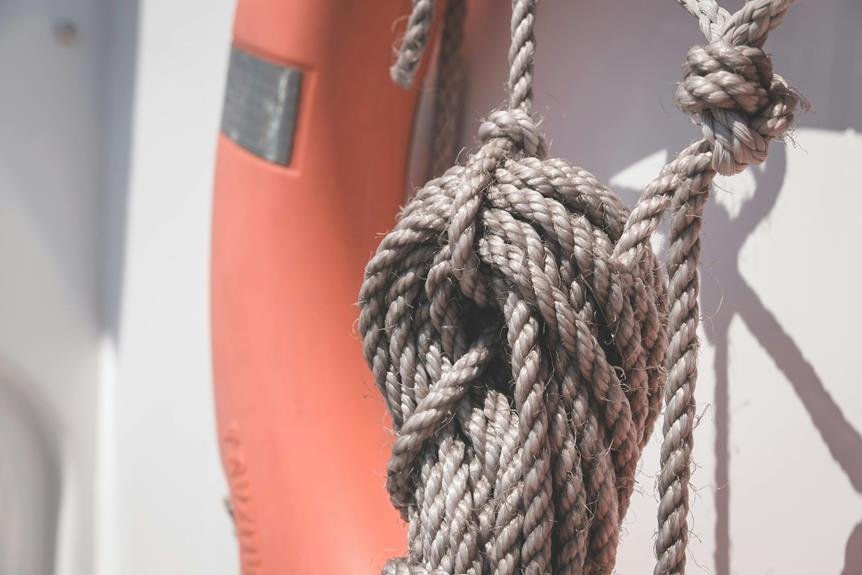To tie an arbor knot, start by twisting the tag end around the standing end of the fishing line to establish a secure foundation. Wrap the line around the spool hub a few times using the tag end, then tie a loose overhand knot in the standing end. Collapse the loop by pulling the standing end, and moisten the knots to reduce friction. Pull slowly and steadily on the standing end until the second overhand knot seats next to the first, guaranteeing a snug connection. By mastering the arbor knot, you'll access the foundation of a successful fishing experience; and there's more to explore on this essential knot.
Key Takeaways
- Twist the tag end around the standing end of the fishing line to establish a secure foundation for the knot.
- Wrap the fishing line around the spool hub a few times using the tag end to secure the knot.
- Tie a loose overhand knot in the standing end of the line, then collapse the loop by pulling the standing end.
- Moistening the knots reduces the chance of line weakening from friction, ensuring a secure connection.
- Pull slowly and steadily on the standing end until the second overhand knot seats or snugs up next to the first overhand knot.
When to Use an Arbor Knot
The arbor knot is a fundamental step in preparing for a day of fishing, as it's often the first knot tied when changing out the fishing line on a reel. This essential knot is imperative for reel maintenance, ensuring a secure connection between the line and reel. In fishing emergencies, a well-tied arbor knot can be the difference between landing a catch and losing valuable time and gear. By understanding when to use an arbor knot, anglers can minimize downtime and maximize their time on the water. Whether switching to a new line or preparing for a fishing trip, the arbor knot is an indispensable tool in every angler's arsenal.
Tying an Arbor Knot
To tie an arbor knot, begin by twisting the tag end around the standing end of the fishing line, establishing a secure foundation for the knot. Next, wrap the fishing line around the spool hub a few times using the tag end. Then, tie a loose overhand knot in the standing end of the line. Collapse the loop by pulling the standing end to slide the first overhand knot toward the spool. This process reinforces knot strength and line durability. By following these steps, you'll create a reliable arbor knot that can withstand the demands of fishing. Moistening the knots reduces the chance of line weakening from friction, fostering a secure connection.
Securing the Knot
Pulling slowly and steadily on the standing end until the second overhand knot seats or snugs up next to the first overhand knot is vital for securing the arbor knot. This guarantees a snug and secure connection, preventing line slippage and maintaining knot strength. To further reinforce the knot, moisten the knots to reduce friction and prevent weakening. Trim the tag end, and wind the fishing line onto the reel. A well-secured arbor knot is essential for a successful fishing experience. By following these steps, anglers can confirm their line is securely attached, allowing for maximum knot strength testing and preventing line slippage. A secure arbor knot provides a solid foundation for a successful fishing trip.
Tips and Variations
With patience and practice, mastering the arbor knot becomes a straightforward process, allowing anglers to focus on more complex knots and fishing techniques. To optimize the arbor knot's performance, consider the following tips and variations:
| Fishing Style | Line Materials | Knot Strength |
|---|---|---|
| Fly Fishing | Monofilament | Medium-High |
| Saltwater Fishing | Fluorocarbon | High |
| Freshwater Fishing | Braided Line | Medium |
When using braided line, a non-slip spool is essential to prevent the line from slipping and reducing knot strength. Additionally, adjusting the knot's tension and using the correct line materials can greatly impact the arbor knot's performance. By understanding these variations and tips, anglers can adapt the arbor knot to suit their specific fishing needs.
Common Mistakes to Avoid
When tying an arbor knot, anglers often overlook critical steps or make careless mistakes that can compromise the knot's integrity, leading to frustrating consequences on the water. One common mistake is failing to moisten the knots, which can cause knot fatigue and line weakening from friction. Another error is applying incorrect tension, resulting in line twist or reel damage. Additionally, overcrowding the spool can lead to tangles and knots, further compromising the arbor knot's integrity. To avoid these mistakes, it's crucial to follow the proper steps, maintain consistent tension, and keep the spool well-organized. By being mindful of these common mistakes, anglers can guarantee a secure and reliable arbor knot that withstands the demands of fishing.
Line Selection and Preparation
Selecting the right fishing line and preparing it properly is a critical step in guaranteeing the arbor knot's reliability and overall fishing experience. The type of fishing line used can profoundly impact the performance of the arbor knot. Factors such as line durability, material, and weight all play a vital role in determining the knot's reliability.
| Fishing Line | Line Durability |
|---|---|
| Monofilament | Medium to High |
| Fluorocarbon | High |
| Braided Line | High to Very High |
When preparing the line, inspect the line for any damage or wear. Remove any weak or damaged sections to guarantee the line is in prime condition. Properly preparing the line will help guarantee a secure and reliable arbor knot.
Advanced Arbor Knot Techniques
Mastering the arbor knot is only the beginning, as advanced techniques can further enhance its reliability and versatility in various fishing applications. In competitive fishing competitions, anglers often rely on innovative knot innovations to gain an edge. One advanced technique is the use of a double arbor knot, which provides added security and reduces the risk of line failure. Another technique is to incorporate a loop-to-loop connection, allowing for quick and easy line changes. By mastering these advanced techniques, anglers can optimize their gear and improve their chances of success in competitive fishing competitions. By pushing the boundaries of knot innovations, anglers can stay ahead of the curve and reel in the big catches.
Additional Fishing Resources
Beyond the arbor knot, a wealth of additional resources is available to enhance the fishing experience and improve angling skills. Join online Fishing Communities to connect with fellow anglers, share tips, and learn from experts. Utilize Angling Apps like Fishidy or Navionics to access detailed fishing maps, track catches, and receive real-time fishing reports. Tune in to informative Fishing Podcasts, such as The Fishing Podcast or The Angler's Podcast, to stay updated on the latest fishing trends and techniques. These resources can help you refine your skills, stay informed about fishing regulations, and discover new fishing spots. By leveraging these resources, you can elevate your fishing game and make the most of your time on the water.
Frequently Asked Questions
Can I Use an Arbor Knot for Saltwater Fishing?
When saltwater fishing, the arbor knot is suitable for most applications, but be cautious when targeting large saltwater species or fishing in strong ocean currents, as the knot's reliability may be compromised under extreme conditions.
How Often Should I Replace My Arbor Knot?
As the ol' sailing captain's adage goes, 'a knot's integrity is only as strong as its weakest thread.' Replace your arbor knot every 6-12 months or sooner if you notice signs of knot degradation or line memory, ensuring a secure connection and peak fishing performance.
Can I Tie an Arbor Knot With Cold Hands?
When winter angling with frosty fingers, tying an arbor knot can be challenging, but not impossible. Use a slow and deliberate approach, focusing on each step to guarantee a secure knot, and consider wearing gloves to improve dexterity.
Is an Arbor Knot Suitable for All Types of Fishing Reels?
An arbor knot is suitable for most freshwater applications, but its suitability depends on reel materials, line durability, and tackle types, making it ideal for species-specific fishing, such as bass or trout, with monofilament or fluorocarbon lines.
Can I Use an Arbor Knot With a Wire Leader?
When it comes to wire leaders, the arbor knot's reliability is tested; wire's rigidity and lack of flexibility can compromise the knot's security, making alternative knots or leader materials, such as monofilament or fluorocarbon, more suitable options.
Conclusion
Mastering the arbor knot is a vital aspect of fishing, as it secures a reliable connection between the fishing line and reel. As the old adage goes, 'a chain is only as strong as its weakest link.' Finally, a well-tied arbor knot is the foundation of a successful fishing experience. By following the outlined steps and tips, anglers can confidently cast their lines, knowing their gear is properly secured, and increasing their chances of a bountiful catch.









